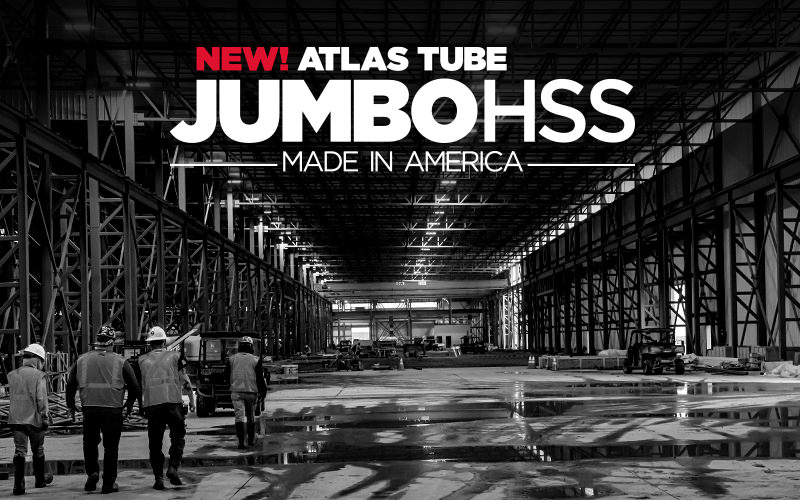It’s not every day that something new comes along in construction, but this September, Atlas Tube will be permanently expanding the toolkit of every architect, engineer and builder in North America. That’s when we’ll start rolling at our new mill, a 515,000-square-foot facility in Blytheville, Arkansas, that will be making the world’s largest HSS.
The Mill
Currently under construction, the mill will be the largest continuous electric resistance weld (ERW) tube mill in the world. Newly developed welders capable of handling 1"-thick sections will let us roll new Atlas Tube Jumbo HSS sizes in lengths up to 125', while quick change technology lets us switch out rollers and stands in under 60 minutes, giving us the shortest cycle times in the industry. At the end of the line, the world’s largest HSS will feed directly into a fully automated warehouse, boosting our logistical efficiency and exceeding customers’ expectations with the shortest delivery times in the industry.
The Steel
The new mill will give Atlas Tube the ability to roll HSS up to 22" square, 28" round and 34" x 10" rectangle, all with walls up to 1" thick. These massive sizes open up exciting construction possibilities, helping to build bigger, stronger structures more efficiently.
So what exactly can these new sizes do?
Go taller. The superiority of HSS in axial load applications only gets better as sizes increase, with up to 30% more available strength than wide-flange sections of comparable weight. That makes it possible to get taller ceilings for more striking aesthetics — or more vertical space to fill, whether it’s in a warehouse or a high-rise’s grand lobby.
Go wider. Stronger columns mean more options when you’re designing unbraced spans — with Jumbo HSS, it’s easier to make big, spacious floor plans, airy atriums and wide-open communal spaces. More widely spaced columns can also help out in industrial applications, letting designers optimize spacing for warehouse storage or increasing efficiencies in manufacturing layouts.
Take up less space. Because the closed shape of HSS is extremely efficient when it comes to axial load and torsional resistance, HSS columns can have smaller footprints than wide-flange sections of the same strength or weight. That makes it easier for architects to hide columns in walls, and it also allows for wider aisles in warehouses.
Save you money. Given the reputation of HSS as a premium material, this can sound a little surprising, but it’s something we’ve found over and over again when working with builders, and it’s only going to become more apparent once our new mill starts rolling.
Because of the efficient way material is used with HSS, the product is much stronger in the weak axis, with less steel than comparable wide-flange sections. That means designers get more strength for less weight, so even though HSS can sometimes cost more per pound than wide-flange sections, architects and engineers can design using as little as half the steel. Those savings continue into construction, with fabrication and contracting costs going down as builders use less steel and fewer pieces.
Finally, HSS have as little as half the surface area of wide-flange sections and can be easily sealed against air and moisture, meaning big potential savings on paint, fireproofing and any other required finishes.
It’s Time to Start Dreaming Big
These properties make Atlas Tube Jumbo HSS a great choice for a huge range of applications, including warehouses, stadiums, convention centers, DOT signs and structural supports, mid- to high-rise buildings, bridges, and airports.
More importantly, Atlas Tube’s new mill and expanded capabilities will remove barriers like unpredictable sourcing timelines and prohibitive import costs that used to keep builders from working with HSS. With an unbeatable size range, short delivery times and the exciting new possibilities jumbo sizes open up, the time’s never been better to start planning big things.






